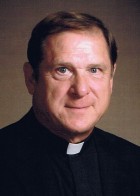Readings for the next two Sundays offer clues on best way to tend the ‘flock’

Father R. Michael Schaab
By Father R. Michael Schaab
Third Sunday of Easter/April 10
Acts 5:27-32,40b-41; Psalm 30:2,4,5-6,11-12,13; Revelation 5:11-14; John 21:1-19
It’s good to look at the Scripture readings for the Third and Fourth Sundays of Easter at the same time because they have much in common, and by examining what they have in common we’ll be able to see what is unique about each Sunday.
On both Sundays the readings rely heavily on two images of Christ — the Lamb and the Shepherd. On the Third Sunday the Book of Revelation speaks of Christ the Lamb: “Worthy is the Lamb that was slain,” and “To the one who sits on the throne and to the Lamb be blessing and honor, glory and might.” This same emphasis is found the next Sunday in the continuing reading from the Book of Revelation: “They stood before the throne and before the Lamb,” and “They have washed their robes and made them white in the blood of the Lamb.”
The image of Christ as Shepherd is likewise in the readings for both Sundays. It is explicit on the Fourth Sunday: “I am the good shepherd, says the Lord,” (Alleluia verse) and “The Good Shepherd has risen, who laid down his life for his sheep.” (Communion antiphon)
The image of the Shepherd is implicit on the same Sunday when the readings state: “We are his people, the sheep of his flock,” (Responsorial Psalm) and “My sheep hear my voice; I know them and they follow me.” (Gospel) Likewise, it is implicit in the Gospel of the Third Sunday: “Jesus said to him, ‘Feed my lambs. . . . Tend my sheep. . . . Feed my sheep.”
LAMB, SHEPHERD OR BOTH?
At first it might seem confusing. What image should we focus on these Sundays — Lamb or Shepherd? However, our confusion is addressed by the readings themselves that make it clear that we are not to choose one image over another. We are to hold both images simultaneously. We are to keep them in balance. On the Fourth Sunday, the Book of Revelation states, “The Lamb who is in the center of the throne will shepherd them.” How do we do it?
The image of the Lamb refers to the risen Christ in glory at the right hand of God. The Shepherd refers to Jesus, the Messiah who through his ministry on earth has conquered sin and death. It is the same Christ but the Lamb is the glorified Christ while the Shepherd is the historical Jesus. Furthermore, the work of the Shepherd continues to our very day in the Mystical Body of Christ, the Church. That is the meaning of His words to Peter, “Tend my sheep.”
Furthermore, the readings make it clear why this Christ, both Lamb and Shepherd, is able to accomplish what he has in his ministry on earth and to be in glory on the throne of heaven. As Jesus says at the end of the Gospel for the Fourth Sunday, “The Father and I are one.” Thus, his ministry was successful because it was God’s work, and his glory is justified because it is God’s glory. Consequently, the work of the Church will succeed because it also is His work, which means that it is the work of God. And the glory that is Christ’s now, will be the promised glory that the Church will attain in heaven.
But what about the differences between these two sets of readings? What is unique about each of these Sundays? It’s all wrapped up in the meaning of the “flock” — the Church.
On the Third Sunday, in the first reading from the Acts of the Apostles, the flock is only the Jewish people. But, by the Fourth Sunday, the flock has expanded in Acts to include the Gentiles, and that means that now we are “his people, the flock he tends.” And not only that, the flock that will gather before God’s throne in heaven will be “from every nation, race, people and tongue.”
So here’s the challenge of these middle Sundays of the Easter Season. Never allow the RCIA (Rite of Christian Initiation of Adults) in our parishes and Newman Centers to rest. Keep evangelizing. Keep calling people to the Church and, thereby, to the throne of God. According to the Book of Revelation on the Fourth Sunday of Easter, the best way for us to tend the sheep is to “lead them to the springs of live-giving water” — to baptism.
—–
FATHER R. MICHAEL Schaab is a senior priest of the Diocese of Peoria who gives retreats and days of recollection, and who fills in as presider at parish Masses on weekends. He resides on a hobby farm in Putnam County.





